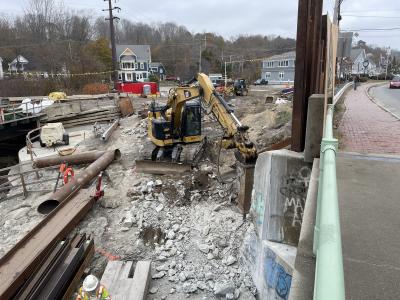OAKDALE, Minn. (AP) To remember the collapse of a busy Minnesota highway bridge, state historians preserved items they thought would vividly convey the chaotic scene that unfolded back in 2007: a battered Interstate 35W sign, an emergency worker’s shirt, the back door of a school bus that young survivors used to escape.
Five years later, most items collected from the rush-hour disaster that killed 13 people and injured scores of others remain tucked away from public view, held back partly by concern that emotions may still be too raw for a museum display.
“I don’t think it would be inconceivable that we would do an exhibition on the event,” said Adam Scher, a collections department curator of the Minnesota Historical Society. “I think perhaps more time does have to lapse before that would be appropriate.”
One day, the collection might even feature mangled pieces of the bridge itself. In a garage half the size of a football field, the Minnesota Department of Transportation has kept steel beams — some crumpled as though they were aluminum cans — and the sheered connector plates that first gave way. The fragments offer a frozen-in-time reminder of the devastating forces that sent the span tumbling into the Mississippi River below.
At the time of the tragedy, historians knew that documenting the disaster would be a sensitive but essential task. They set out to collect items that could tell the story of Bridge No. 9340, its victims and those who rushed to the scene to help.
They came away with the highway sign with the 35W logo, the Red Cross worker’s shirt and the door of the school bus that had come to rest precariously on a fallen slab of concrete. Later they added a commemorative pin from the first anniversary and an ID badge from a worker on a replacement bridge.
For now, the collection can be viewed by appointment only, although there are plans to include a couple of the artifacts in a broader exhibit on Minnesota’s past beginning in November.
To some, there’s a hunger for more.
Chris Messerly, an attorney for more than 100 victims, said his clients worry that the collapse is fading from mind too easily. Letting the public see and touch the massive steel parts that were “twisted like Play-Doh” is vital to preserving the heightened awareness of bridge safety that resulted from the collapse, he said.
“Real things tell a thousand words,” Messerly said. “How could you have a better reminder of a failure of our nation’s infrastructure, one of the busiest interstate highways in the state of Minnesota, in a major metropolitan area, falling 70 feet into the Mississippi River?”
The National Transportation Safety Board attributed the collapse to a 1960s design flaw in plates used to connect bridge beams. The plates were half the thickness they should have been. Investigators also concluded that the weight of construction materials was a contributing factor.
State historians, and everyone else, have been constrained by litigation. The hulking bridge components were deemed evidence in various investigations and lawsuits. While the victims have settled their complaints, legal disputes involving the state and a bridge design firm remain unresolved.
“We can’t do anything until the litigation is over. We’ll figure it out after that,” said Minnesota Department of Transportation spokesman Kevin Gutknecht.
Even then, Gutknecht said, the agency isn’t sure where to draw the line. Some victims have requested pieces, as has a school wanting to use them in its civil engineering program.
The August 1 anniversary was observed with relatively little ceremony. Minnesota Gov. Mark Dayton ordered flags lowered to half-staff. Community leaders and artists planned a gathering near the bridge to reflect on the collapse.
Documenting tragedy has long been a challenge for historians, who must decide how to preserve important remnants without seeming ghoulish.
Objects from the Sept. 11 terrorist attacks have been exhibited at the Smithsonian Institution and elsewhere, including a prominent display at the National Museum of American History just a year after the events.
The National September 11 Memorial and Museum, a permanent tribute housed on the World Trade Center site in lower Manhattan, is almost complete after many years of planning, turf battles and construction delays. It will feature survivor narratives, portraits of the dead, rescue vehicles, artifacts mined from the debris and steel beams from the fallen structures themselves.
“Building the museum on ground that many consider to be sacred is a tremendous responsibility, and the question of how best to preserve the history of 9/11 has come with many challenges,” Joe Daniels, president and chief executive of the museum, acknowledged on its Web site.
In Joplin, Mo., where a monstrous tornado wiped out whole neighborhoods and killed 161 people last year, an independent visual arts gallery has already shown three exhibits on the disaster. One “shoebox project” featured a few dozen items found in the rubble or miles away, including a precious family Bible that emerged in remarkable condition despite being pulled from a demolished apartment building. Everything showcased by the Spiva Center for the Arts was handed over voluntarily.
“We wondered at the time — particularly at the time we did the first exhibit — if enough time had gone by. We wanted to be very respectful,” recalled Executive Director Jo Mueller. “We didn’t want anyone to feel we were exploiting their stories.”
At Joplin’s main museum, officials have been collecting items large and small to illustrate the storm’s force. But Brad Belk, director of the Joplin Museum Complex, said he’s seeking input from the community before deciding on a plan for a permanent exhibit. He has little doubt there will be one.
“Regardless of whatever the tragedy is, it can’t be told with just a plaque. That is so hollow,” Belk said. “People’s lives have been changed forever. Some way, somehow, you have to come to grips with that, and you have to explain that to others.”
Today's top stories















